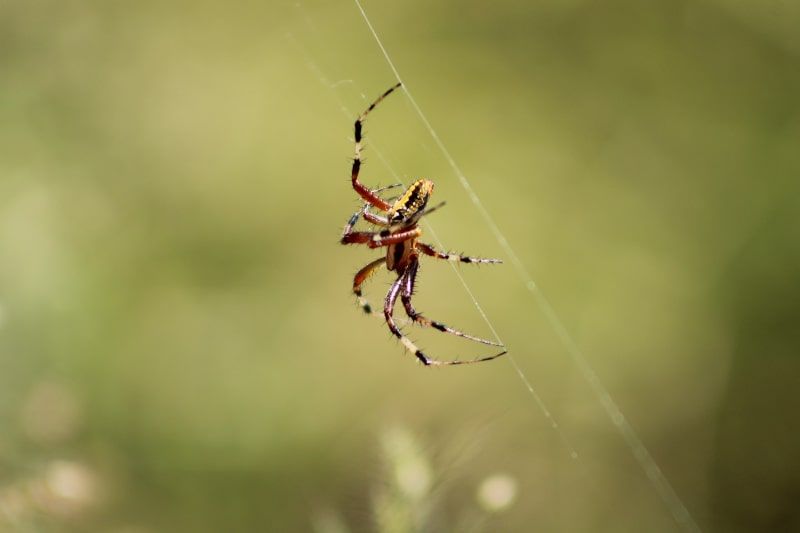The World of Poisons and Antivenoms in Mexico
An overview of the poisons (particularly those of animal origin), the poisonous fauna with medical importance in Mexico, and the current panorama of antivenom production in Mexico are provided in this article.

Poisonings caused by venomous fauna represent one of the greatest medical challenges to overcome; annual cases of snakebite poisoning alone are estimated at 2.5 million worldwide; of these, 85,000 patients die and another 250,000 are left with sequelae (marks from grafts or amputations).
As for accidents caused by arachnids, there are no worldwide epidemiological estimates; however, Mexico has more than 250,000 cases of scorpionism per year, in addition to more than 3,000 cases of poisoning by violin and black widow spiders.
Despite such drastic epidemiological figures, highly efficient antivenoms have been developed in Mexico, ranking among the best qualified worldwide. This article presents a brief description of the poisons (particularly those of animal origin), the poisonous fauna with medical importance in Mexico, and the current panorama of antivenom production in Mexico.
Poisons through time
In ancient times, man used harmful organic compounds from animals, plants, or minerals that caused severe alterations in the organisms where they were administered, even causing death. In some archaeological records, arrowheads from the Paleolithic period have been identified as impregnated with various types of harmful plants, an action attributable to hunting.
Likewise, Vedic texts describe the use of toxic substances for hunting, while the ancient Chinese used aconite for the same purposes. Even the ancient North American Indians used noxious substances from animals such as scorpions and snakes for hunting.
As for present-day indigenous groups, we can cite the Bushmen, who collect plants, snakes, and black spiders to make poisoned arrows; unfortunately, this practice has been forbidden to them for political interests.
Similarly, the Matsés continue to smear the skin secretions of the so-called golden frogs (belonging to the family Dendrobatidae) on arrowheads, as well as using other poisonous frogs (of the family Phyllomedusidae) during their shamanic rituals.
The term poison comes from the Latin venenum, which means "magic potion", and it took a long time to know precisely the composition, physiological effects, and mechanisms of action of the most common poisons. Some Greco-Roman scholars such as Hippocrates, Theophrastus of Eresos (a disciple of Aristotle), and Galen, among others, already described the effects caused by some poisons and proposed remedies to counteract them.
During the late Middle Ages, figures such as Arnau de Vilanova and Pietro d'Abano wrote treatises on poisons and their antidotes, which were widely used by physicians of the time. However, it was not until the 16th century when the Swiss alchemist, physician, and astrologer Paracelsus, began to study poisons and clinical pictures of poisoning to initiate what would later be known as toxicology - from the Greek τοξικον (toxikon), poison, and λογος (logos), study.
Although Paracelsus was not the formal founder of toxicology, he generated the basic principle of this science with one of his most famous statements "Everything is poison, nothing is poison. The dose differentiates a poison from a remedy". After Paracelsus' contributions, Benjamin Scharff published Toxicology, a physical-medical-chemical treatise on the nature of poisons, thus initiating this new science.

Venomous fauna, do animals sting or bite?
We will begin by defining venomous fauna as the group of animals that, in addition to possessing venomous glands, have developed a specialized structure to inoculate their prey with venom, be it a stinger, spines, or fangs. Typical examples are snakes, scorpions, spiders, and bees, among others.
Poisonous animals, on the other hand, correspond to those that, although they produce venom, do not have a structure that allows them to inoculate it, as is the case of certain frogs and toads. Therefore, it is said that poisonous animals can only cause harm if a predator bites or ingests them directly, while venomous organisms are capable of inflicting harm autonomously.
On the question of whether venomous animals sting or bite, they are said to bite if the venom gland is associated with the fangs, as is the case with snakes, spiders, centipedes, and so on. However, it will be considered a sting if the venom gland leads to a thorn or stinger, which occurs in bees, scorpions, and stonefish, among others.
Animal venoms are complex mixtures of proteins, biogenic amines, nucleotides, and salts, among others; however, only some of these components function properly as toxins, which, according to their proportions and physicochemical properties, will generate different poisoning pictures, implying a specific treatment for each venom.

Venomous snakes of Mexico: Viperids and Elapids
Viperids
Among the venomous herpetofauna of Mexico considered to be of medical importance are the snakes of the family Viperidae, which includes the genera Crotalus (rattlesnakes), Agkistrodon (copperheads), and Bothrops (pit vipers), among others. This family of vipers is characterized by solenoglyphous fangs and two quite prominent venom glands supported by their maxillary bone that helps to delimit the body from the head, generating a triangular-looking head.
Other distinctive features of this family are their vertical pupils and the presence of a pair of loreal (or thermoreceptor) pits between the eye and the nostrils. The length of viperids is highly variable; for example, pygmy snakes such as Crotalus triseriatus will reach a maximum size of 68 cm, while species such as Bothrops asper and Crotalus adamanteus could reach three meters in length.
The venoms of these vipers are made up of more than 100 components, including metalloproteases (producing severe hemorrhages), serine proteases (generating coagulopathy), and phospholipase A2 (digesting glycerophospholipids and being myotoxic). Together, these groups of enzymes generate hemorrhagic envenomation pictures and the use of several vials of antivenom is required to neutralize their effects.
Elapids
The second family of snakes that produces severe envenomations in Mexico is the Elapidae, which includes the genera Hydrophis (sea snakes), Micrurus (true corals), and Micruroides (corallids). Elapids have a proteroglyphous dentition and head so small that it is difficult to differentiate them from the body, their eyes have round pupils and lack loreal pits.
In particular, corals and corallids reach sizes of 40 to 80 cm (although sea snakes can measure up to 100 cm), in addition to having a very short tail compared to the rest of the snakes, hence the name of the genus. One of the main characteristics of the elapids is the colored rings distributed on their body, typically red, yellow, and black.
It is important to emphasize that neither the arrangement of the colors nor the number of rings is indicative to differentiate a false coral (lacking venom and belonging to the Colubridae family) from a true one. The poisoning caused by elapids is neurotoxic, generating flaccid paralysis and preventing the correct functioning of the diaphragm, thus triggering death by asphyxia.
Elapid venoms include two main types of toxins, alpha neurotoxins (three-finger toxins) and beta neurotoxins (phospholipase A2); the former bind to the acetylcholine receptor, while the latter prevent the release of acetylcholine.

Venomous arachnids in Mexico: spiders and scorpions
Arachnids, belonging to the class Arachnida, are arthropods that have inhabited the Earth for more than 400 million years. They are characterized by a body divided into an abdomen and cephalothorax, four pairs of legs, a pair of pedipalps (appendages associated with the mouth mistaken for legs when they are very long), and two chelicerae that support the fangs.
Some representative arachnids are spiders, tarantulas, scorpions, mites, and ticks, among others. They are typically mistaken for animals of the class Insecta; however, insects have a three-part body, three pairs of legs, and one pair of antennae and may or may not have wings.
Of the more than 90,000 species of arachnids described so far worldwide, few are considered to be of medical importance. In Mexico, araneism (spider poisoning) is caused exclusively by the genera Latrodectus and Loxosceles, while alacranism (scorpion poisoning) is caused by species of the genus Centruroides.
Latrodectus genus spider poisoning
The genus Latrodectus includes black widow spiders, also called capulins, because they have a shiny black globular body similar to the capulin fruit, in whose abdomen it is common to find the figure of a red hourglass, although it is not always present; they may also have white, red, yellow or no patterns on the abdominal dorsum.
Females are larger than males, reaching an adult size of about five centimeters with legs extended, i.e., they are small and fearful spiders, preferring to shrink and remain still rather than fight for their lives. Despite their size, the venom they produce is highly toxic to humans, its main component being alpha-latrotoxin, a presynaptic neurotoxin that massively releases different neurotransmitters.
Poisoning by this spider (latrodectism) begins between 20 and 120 min after the bite, initially manifesting psychomotor agitation, thoracic oppression, spasms, and, later, the rigidity of abdominal and thoracic muscles, among other symptoms. Latrodectus spider venom can affect humans for several days, but fatalities are rare, unless the patient is in poor health, as in the case of infants and elderly adults.
Loxosceles genus spider poisoning
Spiders of the genus Loxosceles, like black widows, reach small body sizes, barely exceeding four and a half centimeters from leg to leg, and reaching half a centimeter in body length. Their coloration varies from light to dark brown tones and their distinguishing feature is the violin-like figure on the dorsal part of their cephalothorax.
Fiddler spiders are solitary and prefer dark places so as not to be disturbed, such as the corners of furniture or under stones, hence they are also known as corner spiders. Unlike latrodectism, poisoning caused by fiddler spiders (loxoscelism) causes dermal damage due to the effect of sphingomyelinase D toxin, an enzyme that during the first 12 hours triggers an inflammatory process, formation of blisters, edema and, after 24 to 36 hours, develops necrotic marks of variable shape and extension.
This clinical picture is known as cutaneous or local loxoscelism and is the one that occurs most frequently; however, there is another variant of this poisoning known as systemic loxoscelism, in which renal affections, hemolysis, disseminated intravascular coagulation, and death occurs.
Centruroides genus scorpion poisoning
Scorpions (words with different etymology, but with indistinct meanings) are solitary animals and hunters by nature, which also like arid environments and nocturnal activity. They have diverse colorations and sizes that vary according to their stage of development, whether juvenile or adult.
In Mexico, only 15 species of the genus Centruroides are of clinical importance, the most prominent being C. noxius, C. suffusus, and C. limpidus, all of which are distributed along the Pacific coast. In addition to their distribution, toxic species are distinguished by rectangular tail segments and more elongated and slender claws than non-toxic species.
Scorpion venoms are extremely complex and contain several toxins that mainly block sodium and potassium ion channels. These toxins develop painful pictures and neurological, neuromuscular, and cardiovascular alterations. Although there are still deaths due to scorpion bites, in recent years the mortality rate due to scorpion stings have been reduced by up to 95%.

Mexican antivenoms
The treatment used for an animal bite or sting poisoning is the use of antivenins, which are specific for each poison. Antivenoms stop the evolution of the poisoning but do not reverse the damage already caused.
The development of antivenoms begins with the inoculation of a small amount of venom (or a specific toxin) into horses. This process stimulates the equine immune system, favoring the production of immunoglobulins or antibodies capable of neutralizing specific toxins. These antibodies are isolated from horse serum and purified until only type G immunoglobulins (IgG) are obtained.
However, it is known that the use of complete IgG can trigger adverse side reactions in humans, requiring a proteolytic digestion process to obtain only the fragment that binds the toxins. These purified fragments are known as fabotherapeutants and constitute the commercial antivenoms sold in Mexico.
So far, Mexico has developed one of the most efficient antivenoms against scorpions of the Centruroides genus (Alacramyn), far surpassing the neutralizing capacity of antivenoms manufactured in the United States, which has allowed the sale of Alacramyn in the USA.
Likewise, the antivenoms developed against the black widow (Aracmyn) and the fiddler spider (Reclusmyn) have had a great acceptance at the national level due to their great efficacy, especially Aracmyn, due to its rapid therapeutic effect.
In the case of snake envenomation, there are antivenoms against viperids (Antivipmyn) and elapids (Coralmyn) which, unlike those used for arachnids, require higher doses due to the recurrence of envenomation. The neutralizing capacity of Antivipmyn and Coralmyn has been demonstrated against snake venoms from various countries, including those from other continents.
Summary
Considering the worldwide cases of human poisoning caused by different animals, there is a latent need to develop specific antivenoms, in addition to improving those that already exist. Fortunately, Mexico continues to work on this issue to the point of surpassing the treatments that exist in the United States and other countries.
Although this article only described the effect of toxins found in animal venoms, there are other components in venom that, in contrast to toxins, have biological activities such as antimicrobial, analgesic, and vasodilator, among others.
Notes
Veda texts. The term Veda comes from Sanskrit and means revelation or knowledge. In particular, the Vedic scriptures refer to four sacred Indian scriptures corresponding to the Rig Veda, Sama Veda, Yajur Veda, and Atharva Veda. They are considered to be the oldest religious texts in the world, dating back at least 3,500 years. The content includes a collection of hymns, magical incantations, mythological tales, and sacred formulas for attaining enlightenment.
North American Indians. Tribes located between the Atlantic coast and the Mississippi, also known as redskins (although this is now considered a pejorative term).
Bushmen. Indigenous tribes in southern Africa that have prevailed for thousands of years on the continent are distributed in Botswana, Namibia, South Africa, and Angola. It is the most genetically diverse tribe on Earth, from which the ancestors of modern humans diversified.
Matsés. Amazonian tribes still inhabit territories in Brazil and Peru. Until the middle of the 20th century, they lived in isolation, dedicated to hunting and rural activities.
Solenoglyphs. Type of dentition in vipers: mobile, hollow, located in the front part of the jaw.
Proteroglyph. Dentition present in elapids: located in the anterior part of the mouth, they are short, fixed, and grooved.
Ionic channels. Integral proteins that pass through cell membranes resembling a barrel, whose cavity functions as a selective pore that allows the passage of specific ions.
Recurrence of poisoning. In some cases, after administering an antivenom and observing an apparent improvement in the patient, the symptoms of envenomation reappear.
Source: García García F. El mundo de los venenos y antivenenos (The world of poisons and antivenoms). Elementos 118 (2020) 3-8




